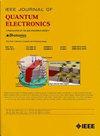Optimization Methods for the Design of Compact and Broadband Adiabatic Couplers
IF 2.2
3区 工程技术
Q3 ENGINEERING, ELECTRICAL & ELECTRONIC
引用次数: 0
Abstract
In this study, optimization methods for the design of the compact and broadband adiabatic couplers are presented. Two definitions of an uncoupled waveguide system are introduced: the first involves connecting one of the two silicon waveguides to a boundary, directing its eigenmodes to the boundary, while the second removes one of the waveguides, resulting in eigenmodes confined to the remaining waveguide. The efficient design of adiabatic couplers is achieved by correcting and fitting the refractive indices of the even and odd eigenmodes in these uncoupled systems. The length of the adiabatic coupler designed by the proposed optimization method can be substantially reduced compared to the conventional linear adiabatic coupler. Calculations for the operating bandwidth of the designed adiabatic coupler show that the proposed optimization method can indeed achieve a paramount wide range of operating bandwidths (power transmission efficiencies of more than 90% are achieved for wavelengths from 1406 nm to 3775 nm). A comparison with other design methods demonstrates that the proposed optimization approach yields a coupler with higher efficiency than previous methods. These findings highlight the potential of this optimization strategy for designing high-performance adiabatic couplers with complex geometries in integrated optics.紧凑型宽频带绝热耦合器的优化设计方法
提出了紧凑型和宽频带绝热耦合器的优化设计方法。介绍了非耦合波导系统的两种定义:第一种是将两个硅波导中的一个连接到边界,将其本征模式指向边界,而第二种是去除其中一个波导,导致本征模式局限于剩余的波导。绝热耦合器的有效设计是通过校正和拟合这些不耦合系统的奇偶本征模的折射率来实现的。与传统的线性绝热耦合器相比,采用该优化方法设计的绝热耦合器的长度大大缩短。对所设计绝热耦合器工作带宽的计算表明,所提出的优化方法确实可以实现最大范围的工作带宽(在1406 nm至3775 nm波长范围内,功率传输效率达到90%以上)。与其他设计方法的比较表明,所提出的优化方法产生的耦合器比以前的方法具有更高的效率。这些发现突出了这种优化策略在设计集成光学中具有复杂几何形状的高性能绝热耦合器方面的潜力。
本文章由计算机程序翻译,如有差异,请以英文原文为准。
求助全文
约1分钟内获得全文
求助全文
来源期刊

IEEE Journal of Quantum Electronics
工程技术-工程:电子与电气
CiteScore
4.70
自引率
4.00%
发文量
99
审稿时长
3.0 months
期刊介绍:
The IEEE Journal of Quantum Electronics is dedicated to the publication of manuscripts reporting novel experimental or theoretical results in the broad field of the science and technology of quantum electronics. The Journal comprises original contributions, both regular papers and letters, describing significant advances in the understanding of quantum electronics phenomena or the demonstration of new devices, systems, or applications. Manuscripts reporting new developments in systems and applications must emphasize quantum electronics principles or devices. The scope of JQE encompasses the generation, propagation, detection, and application of coherent electromagnetic radiation having wavelengths below one millimeter (i.e., in the submillimeter, infrared, visible, ultraviolet, etc., regions). Whether the focus of a manuscript is a quantum-electronic device or phenomenon, the critical factor in the editorial review of a manuscript is the potential impact of the results presented on continuing research in the field or on advancing the technological base of quantum electronics.
 求助内容:
求助内容: 应助结果提醒方式:
应助结果提醒方式:


